Pharmacological Analysis of Memantine and Galantamine in AD
VerifiedAdded on 2022/09/08
|13
|5063
|36
Report
AI Summary
This assignment analyzes the pharmacotherapeutics of memantine and galantamine in the context of Alzheimer's disease (AD). It begins by introducing AD as a significant health concern, detailing its impact on older adults and caregivers. The report focuses on the mechanisms of action, pharmacokinetics, and pharmacodynamics of both drugs. Galantamine, a cholinesterase inhibitor, is discussed in terms of its dual action on acetylcholinesterase and nicotinic receptors, aiming to improve cognitive function. The assignment also explores the effects of galantamine on other neurotransmitters and its impact on AD symptoms. Memantine, an NMDA receptor antagonist, is analyzed for its role in modulating glutamatergic neurotransmission and its potential to reduce neurofibrillary tangle formation. The report also addresses the pharmacokinetic profiles of both drugs, including absorption, distribution, metabolism, and elimination, as well as potential drug interactions and side effects. Finally, it highlights the clinical implications of these pharmacotherapeutic interventions in managing AD and improving patient outcomes.
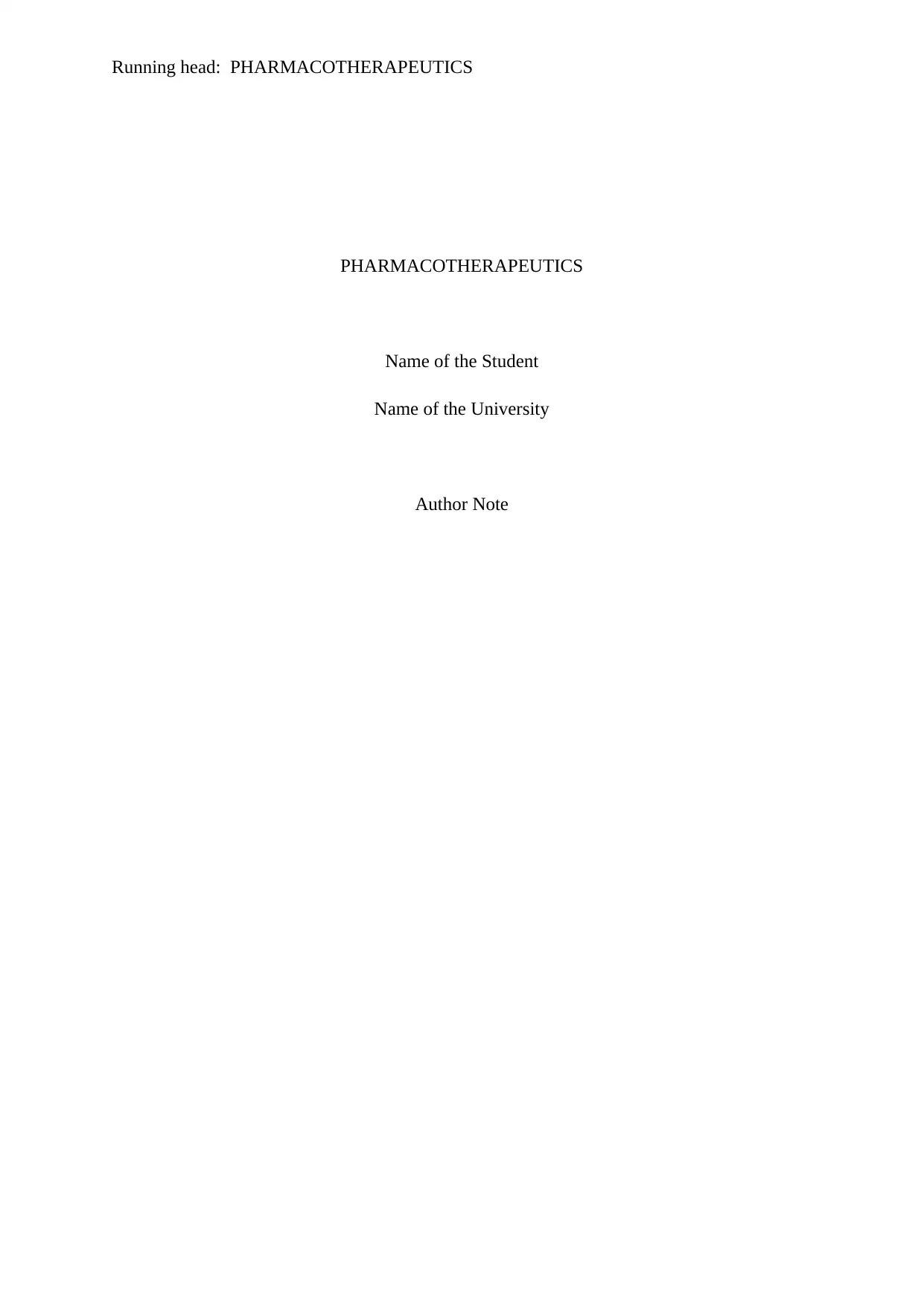
Running head: PHARMACOTHERAPEUTICS
PHARMACOTHERAPEUTICS
Name of the Student
Name of the University
Author Note
PHARMACOTHERAPEUTICS
Name of the Student
Name of the University
Author Note
Paraphrase This Document
Need a fresh take? Get an instant paraphrase of this document with our AI Paraphraser
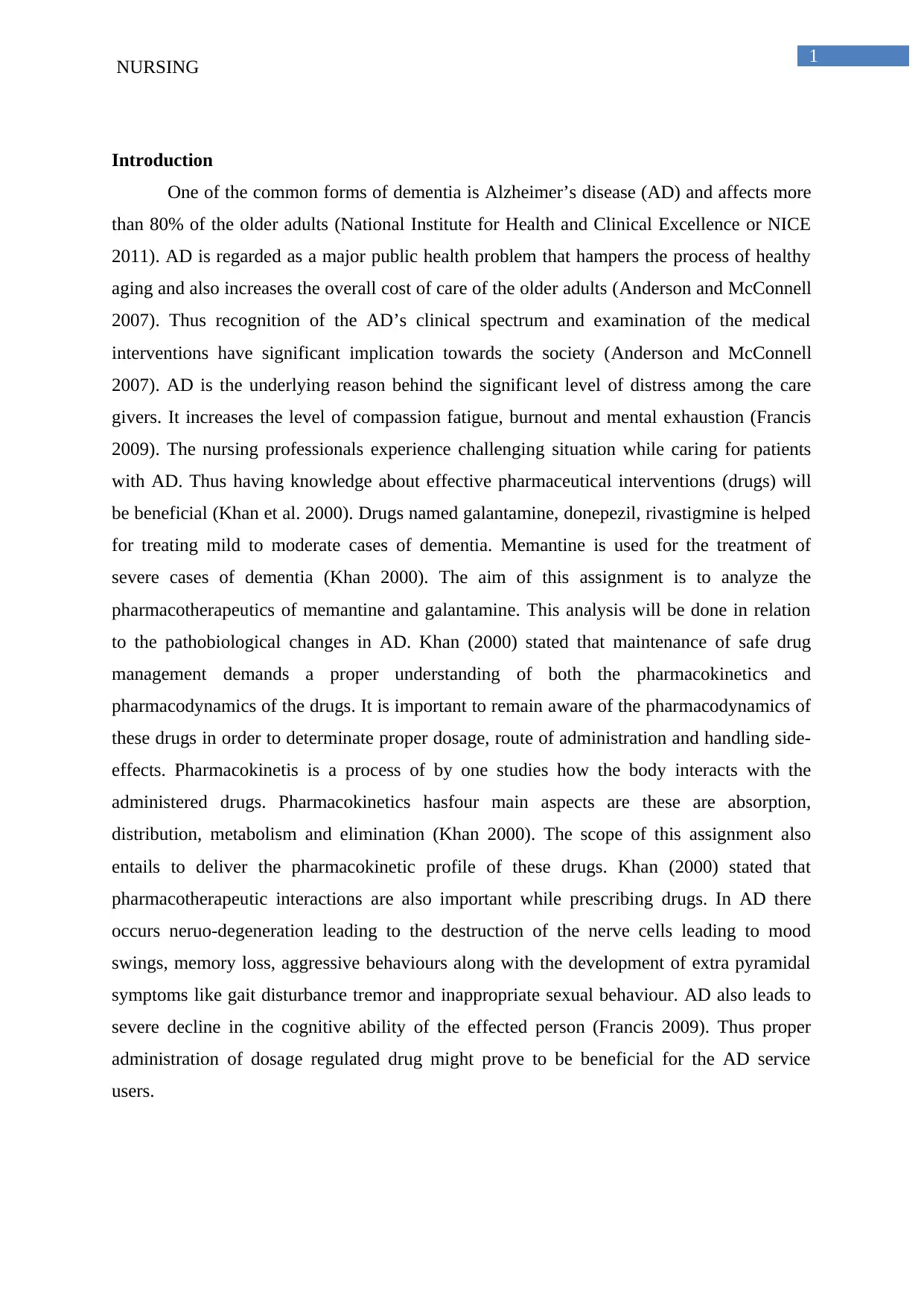
1
NURSING
Introduction
One of the common forms of dementia is Alzheimer’s disease (AD) and affects more
than 80% of the older adults (National Institute for Health and Clinical Excellence or NICE
2011). AD is regarded as a major public health problem that hampers the process of healthy
aging and also increases the overall cost of care of the older adults (Anderson and McConnell
2007). Thus recognition of the AD’s clinical spectrum and examination of the medical
interventions have significant implication towards the society (Anderson and McConnell
2007). AD is the underlying reason behind the significant level of distress among the care
givers. It increases the level of compassion fatigue, burnout and mental exhaustion (Francis
2009). The nursing professionals experience challenging situation while caring for patients
with AD. Thus having knowledge about effective pharmaceutical interventions (drugs) will
be beneficial (Khan et al. 2000). Drugs named galantamine, donepezil, rivastigmine is helped
for treating mild to moderate cases of dementia. Memantine is used for the treatment of
severe cases of dementia (Khan 2000). The aim of this assignment is to analyze the
pharmacotherapeutics of memantine and galantamine. This analysis will be done in relation
to the pathobiological changes in AD. Khan (2000) stated that maintenance of safe drug
management demands a proper understanding of both the pharmacokinetics and
pharmacodynamics of the drugs. It is important to remain aware of the pharmacodynamics of
these drugs in order to determinate proper dosage, route of administration and handling side-
effects. Pharmacokinetis is a process of by one studies how the body interacts with the
administered drugs. Pharmacokinetics hasfour main aspects are these are absorption,
distribution, metabolism and elimination (Khan 2000). The scope of this assignment also
entails to deliver the pharmacokinetic profile of these drugs. Khan (2000) stated that
pharmacotherapeutic interactions are also important while prescribing drugs. In AD there
occurs neruo-degeneration leading to the destruction of the nerve cells leading to mood
swings, memory loss, aggressive behaviours along with the development of extra pyramidal
symptoms like gait disturbance tremor and inappropriate sexual behaviour. AD also leads to
severe decline in the cognitive ability of the effected person (Francis 2009). Thus proper
administration of dosage regulated drug might prove to be beneficial for the AD service
users.
NURSING
Introduction
One of the common forms of dementia is Alzheimer’s disease (AD) and affects more
than 80% of the older adults (National Institute for Health and Clinical Excellence or NICE
2011). AD is regarded as a major public health problem that hampers the process of healthy
aging and also increases the overall cost of care of the older adults (Anderson and McConnell
2007). Thus recognition of the AD’s clinical spectrum and examination of the medical
interventions have significant implication towards the society (Anderson and McConnell
2007). AD is the underlying reason behind the significant level of distress among the care
givers. It increases the level of compassion fatigue, burnout and mental exhaustion (Francis
2009). The nursing professionals experience challenging situation while caring for patients
with AD. Thus having knowledge about effective pharmaceutical interventions (drugs) will
be beneficial (Khan et al. 2000). Drugs named galantamine, donepezil, rivastigmine is helped
for treating mild to moderate cases of dementia. Memantine is used for the treatment of
severe cases of dementia (Khan 2000). The aim of this assignment is to analyze the
pharmacotherapeutics of memantine and galantamine. This analysis will be done in relation
to the pathobiological changes in AD. Khan (2000) stated that maintenance of safe drug
management demands a proper understanding of both the pharmacokinetics and
pharmacodynamics of the drugs. It is important to remain aware of the pharmacodynamics of
these drugs in order to determinate proper dosage, route of administration and handling side-
effects. Pharmacokinetis is a process of by one studies how the body interacts with the
administered drugs. Pharmacokinetics hasfour main aspects are these are absorption,
distribution, metabolism and elimination (Khan 2000). The scope of this assignment also
entails to deliver the pharmacokinetic profile of these drugs. Khan (2000) stated that
pharmacotherapeutic interactions are also important while prescribing drugs. In AD there
occurs neruo-degeneration leading to the destruction of the nerve cells leading to mood
swings, memory loss, aggressive behaviours along with the development of extra pyramidal
symptoms like gait disturbance tremor and inappropriate sexual behaviour. AD also leads to
severe decline in the cognitive ability of the effected person (Francis 2009). Thus proper
administration of dosage regulated drug might prove to be beneficial for the AD service
users.
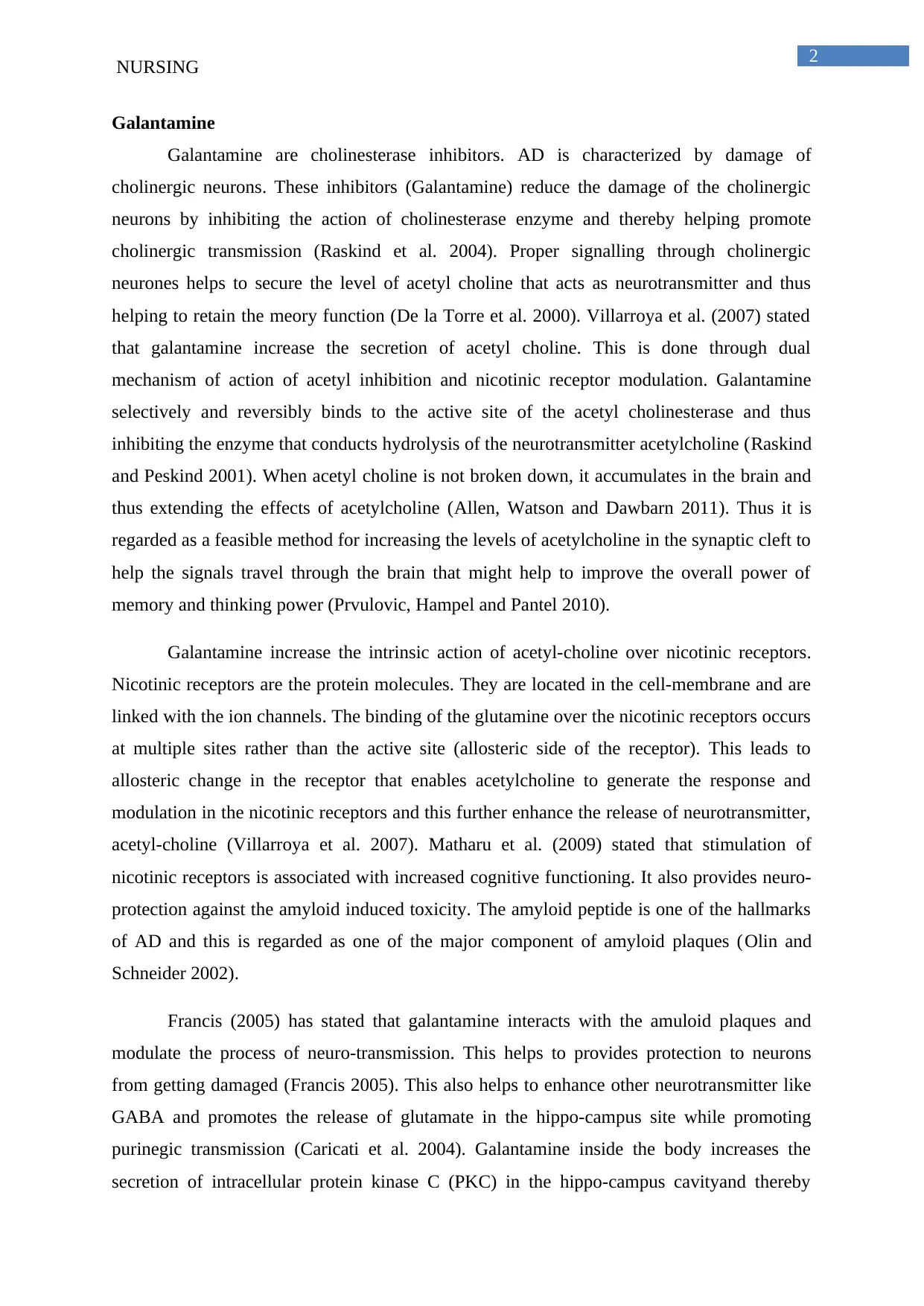
2
NURSING
Galantamine
Galantamine are cholinesterase inhibitors. AD is characterized by damage of
cholinergic neurons. These inhibitors (Galantamine) reduce the damage of the cholinergic
neurons by inhibiting the action of cholinesterase enzyme and thereby helping promote
cholinergic transmission (Raskind et al. 2004). Proper signalling through cholinergic
neurones helps to secure the level of acetyl choline that acts as neurotransmitter and thus
helping to retain the meory function (De la Torre et al. 2000). Villarroya et al. (2007) stated
that galantamine increase the secretion of acetyl choline. This is done through dual
mechanism of action of acetyl inhibition and nicotinic receptor modulation. Galantamine
selectively and reversibly binds to the active site of the acetyl cholinesterase and thus
inhibiting the enzyme that conducts hydrolysis of the neurotransmitter acetylcholine (Raskind
and Peskind 2001). When acetyl choline is not broken down, it accumulates in the brain and
thus extending the effects of acetylcholine (Allen, Watson and Dawbarn 2011). Thus it is
regarded as a feasible method for increasing the levels of acetylcholine in the synaptic cleft to
help the signals travel through the brain that might help to improve the overall power of
memory and thinking power (Prvulovic, Hampel and Pantel 2010).
Galantamine increase the intrinsic action of acetyl-choline over nicotinic receptors.
Nicotinic receptors are the protein molecules. They are located in the cell-membrane and are
linked with the ion channels. The binding of the glutamine over the nicotinic receptors occurs
at multiple sites rather than the active site (allosteric side of the receptor). This leads to
allosteric change in the receptor that enables acetylcholine to generate the response and
modulation in the nicotinic receptors and this further enhance the release of neurotransmitter,
acetyl-choline (Villarroya et al. 2007). Matharu et al. (2009) stated that stimulation of
nicotinic receptors is associated with increased cognitive functioning. It also provides neuro-
protection against the amyloid induced toxicity. The amyloid peptide is one of the hallmarks
of AD and this is regarded as one of the major component of amyloid plaques (Olin and
Schneider 2002).
Francis (2005) has stated that galantamine interacts with the amuloid plaques and
modulate the process of neuro-transmission. This helps to provides protection to neurons
from getting damaged (Francis 2005). This also helps to enhance other neurotransmitter like
GABA and promotes the release of glutamate in the hippo-campus site while promoting
purinegic transmission (Caricati et al. 2004). Galantamine inside the body increases the
secretion of intracellular protein kinase C (PKC) in the hippo-campus cavityand thereby
NURSING
Galantamine
Galantamine are cholinesterase inhibitors. AD is characterized by damage of
cholinergic neurons. These inhibitors (Galantamine) reduce the damage of the cholinergic
neurons by inhibiting the action of cholinesterase enzyme and thereby helping promote
cholinergic transmission (Raskind et al. 2004). Proper signalling through cholinergic
neurones helps to secure the level of acetyl choline that acts as neurotransmitter and thus
helping to retain the meory function (De la Torre et al. 2000). Villarroya et al. (2007) stated
that galantamine increase the secretion of acetyl choline. This is done through dual
mechanism of action of acetyl inhibition and nicotinic receptor modulation. Galantamine
selectively and reversibly binds to the active site of the acetyl cholinesterase and thus
inhibiting the enzyme that conducts hydrolysis of the neurotransmitter acetylcholine (Raskind
and Peskind 2001). When acetyl choline is not broken down, it accumulates in the brain and
thus extending the effects of acetylcholine (Allen, Watson and Dawbarn 2011). Thus it is
regarded as a feasible method for increasing the levels of acetylcholine in the synaptic cleft to
help the signals travel through the brain that might help to improve the overall power of
memory and thinking power (Prvulovic, Hampel and Pantel 2010).
Galantamine increase the intrinsic action of acetyl-choline over nicotinic receptors.
Nicotinic receptors are the protein molecules. They are located in the cell-membrane and are
linked with the ion channels. The binding of the glutamine over the nicotinic receptors occurs
at multiple sites rather than the active site (allosteric side of the receptor). This leads to
allosteric change in the receptor that enables acetylcholine to generate the response and
modulation in the nicotinic receptors and this further enhance the release of neurotransmitter,
acetyl-choline (Villarroya et al. 2007). Matharu et al. (2009) stated that stimulation of
nicotinic receptors is associated with increased cognitive functioning. It also provides neuro-
protection against the amyloid induced toxicity. The amyloid peptide is one of the hallmarks
of AD and this is regarded as one of the major component of amyloid plaques (Olin and
Schneider 2002).
Francis (2005) has stated that galantamine interacts with the amuloid plaques and
modulate the process of neuro-transmission. This helps to provides protection to neurons
from getting damaged (Francis 2005). This also helps to enhance other neurotransmitter like
GABA and promotes the release of glutamate in the hippo-campus site while promoting
purinegic transmission (Caricati et al. 2004). Galantamine inside the body increases the
secretion of intracellular protein kinase C (PKC) in the hippo-campus cavityand thereby
⊘ This is a preview!⊘
Do you want full access?
Subscribe today to unlock all pages.

Trusted by 1+ million students worldwide
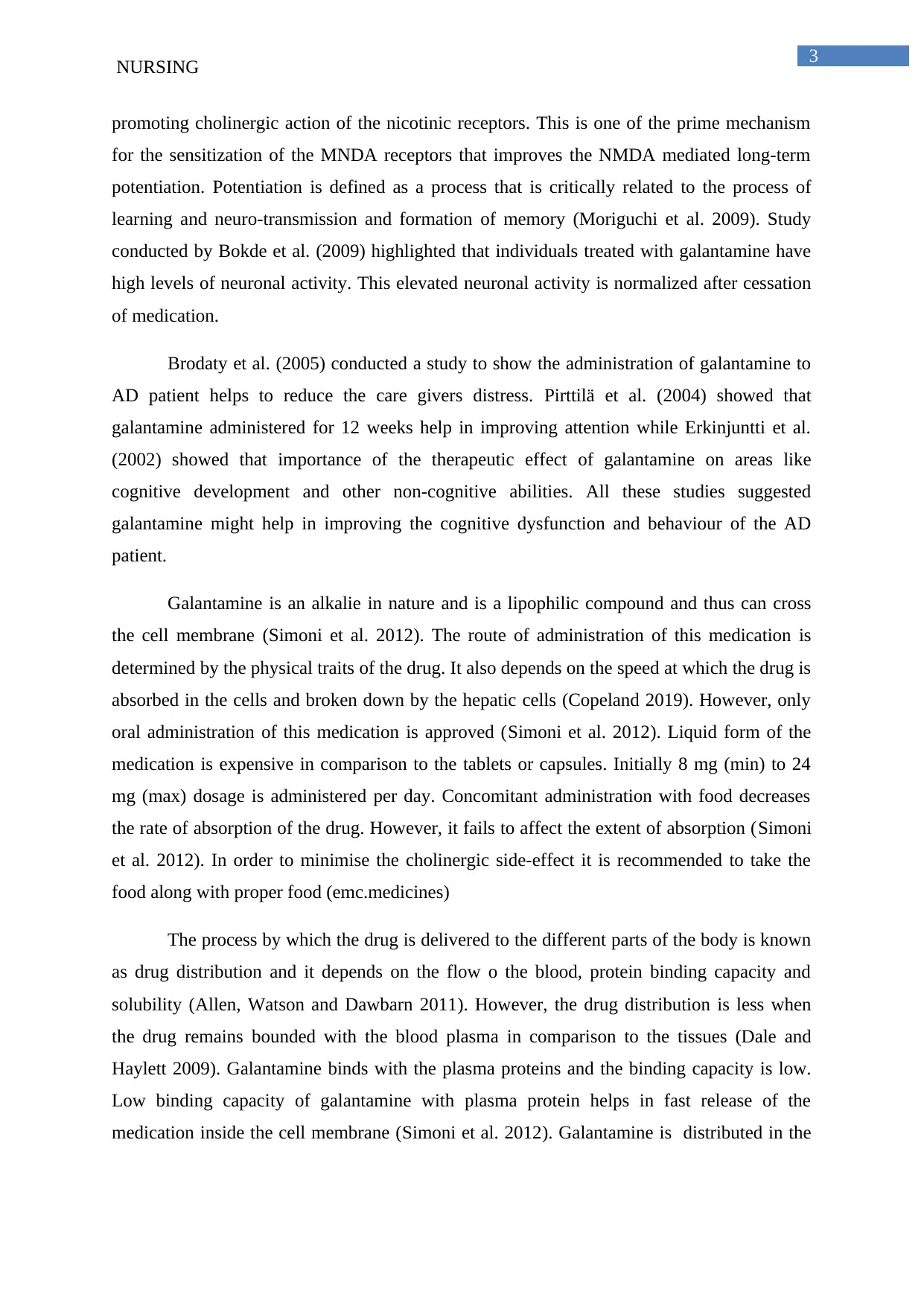
3
NURSING
promoting cholinergic action of the nicotinic receptors. This is one of the prime mechanism
for the sensitization of the MNDA receptors that improves the NMDA mediated long-term
potentiation. Potentiation is defined as a process that is critically related to the process of
learning and neuro-transmission and formation of memory (Moriguchi et al. 2009). Study
conducted by Bokde et al. (2009) highlighted that individuals treated with galantamine have
high levels of neuronal activity. This elevated neuronal activity is normalized after cessation
of medication.
Brodaty et al. (2005) conducted a study to show the administration of galantamine to
AD patient helps to reduce the care givers distress. Pirttilä et al. (2004) showed that
galantamine administered for 12 weeks help in improving attention while Erkinjuntti et al.
(2002) showed that importance of the therapeutic effect of galantamine on areas like
cognitive development and other non-cognitive abilities. All these studies suggested
galantamine might help in improving the cognitive dysfunction and behaviour of the AD
patient.
Galantamine is an alkalie in nature and is a lipophilic compound and thus can cross
the cell membrane (Simoni et al. 2012). The route of administration of this medication is
determined by the physical traits of the drug. It also depends on the speed at which the drug is
absorbed in the cells and broken down by the hepatic cells (Copeland 2019). However, only
oral administration of this medication is approved (Simoni et al. 2012). Liquid form of the
medication is expensive in comparison to the tablets or capsules. Initially 8 mg (min) to 24
mg (max) dosage is administered per day. Concomitant administration with food decreases
the rate of absorption of the drug. However, it fails to affect the extent of absorption (Simoni
et al. 2012). In order to minimise the cholinergic side-effect it is recommended to take the
food along with proper food (emc.medicines)
The process by which the drug is delivered to the different parts of the body is known
as drug distribution and it depends on the flow o the blood, protein binding capacity and
solubility (Allen, Watson and Dawbarn 2011). However, the drug distribution is less when
the drug remains bounded with the blood plasma in comparison to the tissues (Dale and
Haylett 2009). Galantamine binds with the plasma proteins and the binding capacity is low.
Low binding capacity of galantamine with plasma protein helps in fast release of the
medication inside the cell membrane (Simoni et al. 2012). Galantamine is distributed in the
NURSING
promoting cholinergic action of the nicotinic receptors. This is one of the prime mechanism
for the sensitization of the MNDA receptors that improves the NMDA mediated long-term
potentiation. Potentiation is defined as a process that is critically related to the process of
learning and neuro-transmission and formation of memory (Moriguchi et al. 2009). Study
conducted by Bokde et al. (2009) highlighted that individuals treated with galantamine have
high levels of neuronal activity. This elevated neuronal activity is normalized after cessation
of medication.
Brodaty et al. (2005) conducted a study to show the administration of galantamine to
AD patient helps to reduce the care givers distress. Pirttilä et al. (2004) showed that
galantamine administered for 12 weeks help in improving attention while Erkinjuntti et al.
(2002) showed that importance of the therapeutic effect of galantamine on areas like
cognitive development and other non-cognitive abilities. All these studies suggested
galantamine might help in improving the cognitive dysfunction and behaviour of the AD
patient.
Galantamine is an alkalie in nature and is a lipophilic compound and thus can cross
the cell membrane (Simoni et al. 2012). The route of administration of this medication is
determined by the physical traits of the drug. It also depends on the speed at which the drug is
absorbed in the cells and broken down by the hepatic cells (Copeland 2019). However, only
oral administration of this medication is approved (Simoni et al. 2012). Liquid form of the
medication is expensive in comparison to the tablets or capsules. Initially 8 mg (min) to 24
mg (max) dosage is administered per day. Concomitant administration with food decreases
the rate of absorption of the drug. However, it fails to affect the extent of absorption (Simoni
et al. 2012). In order to minimise the cholinergic side-effect it is recommended to take the
food along with proper food (emc.medicines)
The process by which the drug is delivered to the different parts of the body is known
as drug distribution and it depends on the flow o the blood, protein binding capacity and
solubility (Allen, Watson and Dawbarn 2011). However, the drug distribution is less when
the drug remains bounded with the blood plasma in comparison to the tissues (Dale and
Haylett 2009). Galantamine binds with the plasma proteins and the binding capacity is low.
Low binding capacity of galantamine with plasma protein helps in fast release of the
medication inside the cell membrane (Simoni et al. 2012). Galantamine is distributed in the
Paraphrase This Document
Need a fresh take? Get an instant paraphrase of this document with our AI Paraphraser
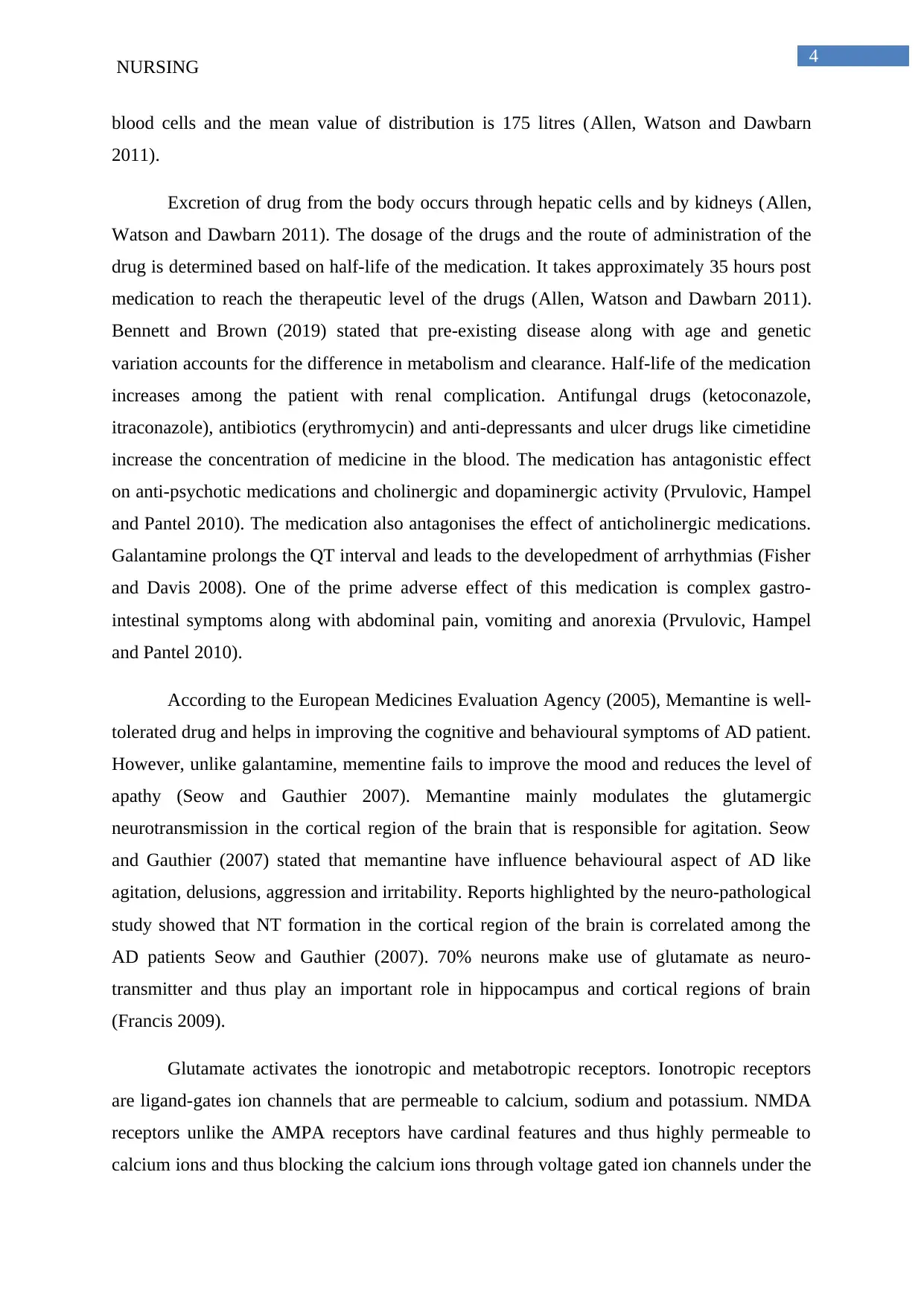
4
NURSING
blood cells and the mean value of distribution is 175 litres (Allen, Watson and Dawbarn
2011).
Excretion of drug from the body occurs through hepatic cells and by kidneys (Allen,
Watson and Dawbarn 2011). The dosage of the drugs and the route of administration of the
drug is determined based on half-life of the medication. It takes approximately 35 hours post
medication to reach the therapeutic level of the drugs (Allen, Watson and Dawbarn 2011).
Bennett and Brown (2019) stated that pre-existing disease along with age and genetic
variation accounts for the difference in metabolism and clearance. Half-life of the medication
increases among the patient with renal complication. Antifungal drugs (ketoconazole,
itraconazole), antibiotics (erythromycin) and anti-depressants and ulcer drugs like cimetidine
increase the concentration of medicine in the blood. The medication has antagonistic effect
on anti-psychotic medications and cholinergic and dopaminergic activity (Prvulovic, Hampel
and Pantel 2010). The medication also antagonises the effect of anticholinergic medications.
Galantamine prolongs the QT interval and leads to the developedment of arrhythmias (Fisher
and Davis 2008). One of the prime adverse effect of this medication is complex gastro-
intestinal symptoms along with abdominal pain, vomiting and anorexia (Prvulovic, Hampel
and Pantel 2010).
According to the European Medicines Evaluation Agency (2005), Memantine is well-
tolerated drug and helps in improving the cognitive and behavioural symptoms of AD patient.
However, unlike galantamine, mementine fails to improve the mood and reduces the level of
apathy (Seow and Gauthier 2007). Memantine mainly modulates the glutamergic
neurotransmission in the cortical region of the brain that is responsible for agitation. Seow
and Gauthier (2007) stated that memantine have influence behavioural aspect of AD like
agitation, delusions, aggression and irritability. Reports highlighted by the neuro-pathological
study showed that NT formation in the cortical region of the brain is correlated among the
AD patients Seow and Gauthier (2007). 70% neurons make use of glutamate as neuro-
transmitter and thus play an important role in hippocampus and cortical regions of brain
(Francis 2009).
Glutamate activates the ionotropic and metabotropic receptors. Ionotropic receptors
are ligand-gates ion channels that are permeable to calcium, sodium and potassium. NMDA
receptors unlike the AMPA receptors have cardinal features and thus highly permeable to
calcium ions and thus blocking the calcium ions through voltage gated ion channels under the
NURSING
blood cells and the mean value of distribution is 175 litres (Allen, Watson and Dawbarn
2011).
Excretion of drug from the body occurs through hepatic cells and by kidneys (Allen,
Watson and Dawbarn 2011). The dosage of the drugs and the route of administration of the
drug is determined based on half-life of the medication. It takes approximately 35 hours post
medication to reach the therapeutic level of the drugs (Allen, Watson and Dawbarn 2011).
Bennett and Brown (2019) stated that pre-existing disease along with age and genetic
variation accounts for the difference in metabolism and clearance. Half-life of the medication
increases among the patient with renal complication. Antifungal drugs (ketoconazole,
itraconazole), antibiotics (erythromycin) and anti-depressants and ulcer drugs like cimetidine
increase the concentration of medicine in the blood. The medication has antagonistic effect
on anti-psychotic medications and cholinergic and dopaminergic activity (Prvulovic, Hampel
and Pantel 2010). The medication also antagonises the effect of anticholinergic medications.
Galantamine prolongs the QT interval and leads to the developedment of arrhythmias (Fisher
and Davis 2008). One of the prime adverse effect of this medication is complex gastro-
intestinal symptoms along with abdominal pain, vomiting and anorexia (Prvulovic, Hampel
and Pantel 2010).
According to the European Medicines Evaluation Agency (2005), Memantine is well-
tolerated drug and helps in improving the cognitive and behavioural symptoms of AD patient.
However, unlike galantamine, mementine fails to improve the mood and reduces the level of
apathy (Seow and Gauthier 2007). Memantine mainly modulates the glutamergic
neurotransmission in the cortical region of the brain that is responsible for agitation. Seow
and Gauthier (2007) stated that memantine have influence behavioural aspect of AD like
agitation, delusions, aggression and irritability. Reports highlighted by the neuro-pathological
study showed that NT formation in the cortical region of the brain is correlated among the
AD patients Seow and Gauthier (2007). 70% neurons make use of glutamate as neuro-
transmitter and thus play an important role in hippocampus and cortical regions of brain
(Francis 2009).
Glutamate activates the ionotropic and metabotropic receptors. Ionotropic receptors
are ligand-gates ion channels that are permeable to calcium, sodium and potassium. NMDA
receptors unlike the AMPA receptors have cardinal features and thus highly permeable to
calcium ions and thus blocking the calcium ions through voltage gated ion channels under the
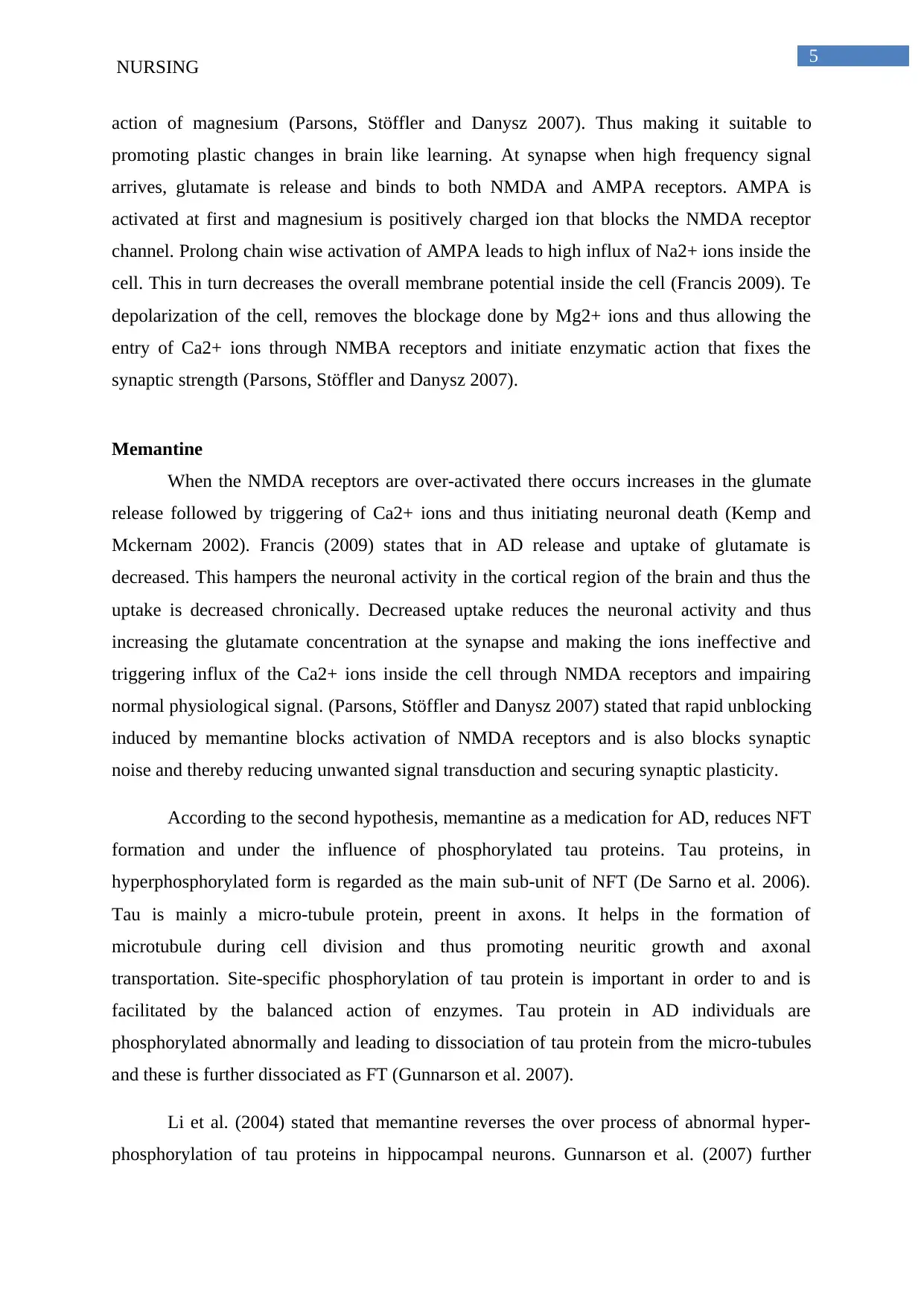
5
NURSING
action of magnesium (Parsons, Stöffler and Danysz 2007). Thus making it suitable to
promoting plastic changes in brain like learning. At synapse when high frequency signal
arrives, glutamate is release and binds to both NMDA and AMPA receptors. AMPA is
activated at first and magnesium is positively charged ion that blocks the NMDA receptor
channel. Prolong chain wise activation of AMPA leads to high influx of Na2+ ions inside the
cell. This in turn decreases the overall membrane potential inside the cell (Francis 2009). Te
depolarization of the cell, removes the blockage done by Mg2+ ions and thus allowing the
entry of Ca2+ ions through NMBA receptors and initiate enzymatic action that fixes the
synaptic strength (Parsons, Stöffler and Danysz 2007).
Memantine
When the NMDA receptors are over-activated there occurs increases in the glumate
release followed by triggering of Ca2+ ions and thus initiating neuronal death (Kemp and
Mckernam 2002). Francis (2009) states that in AD release and uptake of glutamate is
decreased. This hampers the neuronal activity in the cortical region of the brain and thus the
uptake is decreased chronically. Decreased uptake reduces the neuronal activity and thus
increasing the glutamate concentration at the synapse and making the ions ineffective and
triggering influx of the Ca2+ ions inside the cell through NMDA receptors and impairing
normal physiological signal. (Parsons, Stöffler and Danysz 2007) stated that rapid unblocking
induced by memantine blocks activation of NMDA receptors and is also blocks synaptic
noise and thereby reducing unwanted signal transduction and securing synaptic plasticity.
According to the second hypothesis, memantine as a medication for AD, reduces NFT
formation and under the influence of phosphorylated tau proteins. Tau proteins, in
hyperphosphorylated form is regarded as the main sub-unit of NFT (De Sarno et al. 2006).
Tau is mainly a micro-tubule protein, preent in axons. It helps in the formation of
microtubule during cell division and thus promoting neuritic growth and axonal
transportation. Site-specific phosphorylation of tau protein is important in order to and is
facilitated by the balanced action of enzymes. Tau protein in AD individuals are
phosphorylated abnormally and leading to dissociation of tau protein from the micro-tubules
and these is further dissociated as FT (Gunnarson et al. 2007).
Li et al. (2004) stated that memantine reverses the over process of abnormal hyper-
phosphorylation of tau proteins in hippocampal neurons. Gunnarson et al. (2007) further
NURSING
action of magnesium (Parsons, Stöffler and Danysz 2007). Thus making it suitable to
promoting plastic changes in brain like learning. At synapse when high frequency signal
arrives, glutamate is release and binds to both NMDA and AMPA receptors. AMPA is
activated at first and magnesium is positively charged ion that blocks the NMDA receptor
channel. Prolong chain wise activation of AMPA leads to high influx of Na2+ ions inside the
cell. This in turn decreases the overall membrane potential inside the cell (Francis 2009). Te
depolarization of the cell, removes the blockage done by Mg2+ ions and thus allowing the
entry of Ca2+ ions through NMBA receptors and initiate enzymatic action that fixes the
synaptic strength (Parsons, Stöffler and Danysz 2007).
Memantine
When the NMDA receptors are over-activated there occurs increases in the glumate
release followed by triggering of Ca2+ ions and thus initiating neuronal death (Kemp and
Mckernam 2002). Francis (2009) states that in AD release and uptake of glutamate is
decreased. This hampers the neuronal activity in the cortical region of the brain and thus the
uptake is decreased chronically. Decreased uptake reduces the neuronal activity and thus
increasing the glutamate concentration at the synapse and making the ions ineffective and
triggering influx of the Ca2+ ions inside the cell through NMDA receptors and impairing
normal physiological signal. (Parsons, Stöffler and Danysz 2007) stated that rapid unblocking
induced by memantine blocks activation of NMDA receptors and is also blocks synaptic
noise and thereby reducing unwanted signal transduction and securing synaptic plasticity.
According to the second hypothesis, memantine as a medication for AD, reduces NFT
formation and under the influence of phosphorylated tau proteins. Tau proteins, in
hyperphosphorylated form is regarded as the main sub-unit of NFT (De Sarno et al. 2006).
Tau is mainly a micro-tubule protein, preent in axons. It helps in the formation of
microtubule during cell division and thus promoting neuritic growth and axonal
transportation. Site-specific phosphorylation of tau protein is important in order to and is
facilitated by the balanced action of enzymes. Tau protein in AD individuals are
phosphorylated abnormally and leading to dissociation of tau protein from the micro-tubules
and these is further dissociated as FT (Gunnarson et al. 2007).
Li et al. (2004) stated that memantine reverses the over process of abnormal hyper-
phosphorylation of tau proteins in hippocampal neurons. Gunnarson et al. (2007) further
⊘ This is a preview!⊘
Do you want full access?
Subscribe today to unlock all pages.

Trusted by 1+ million students worldwide
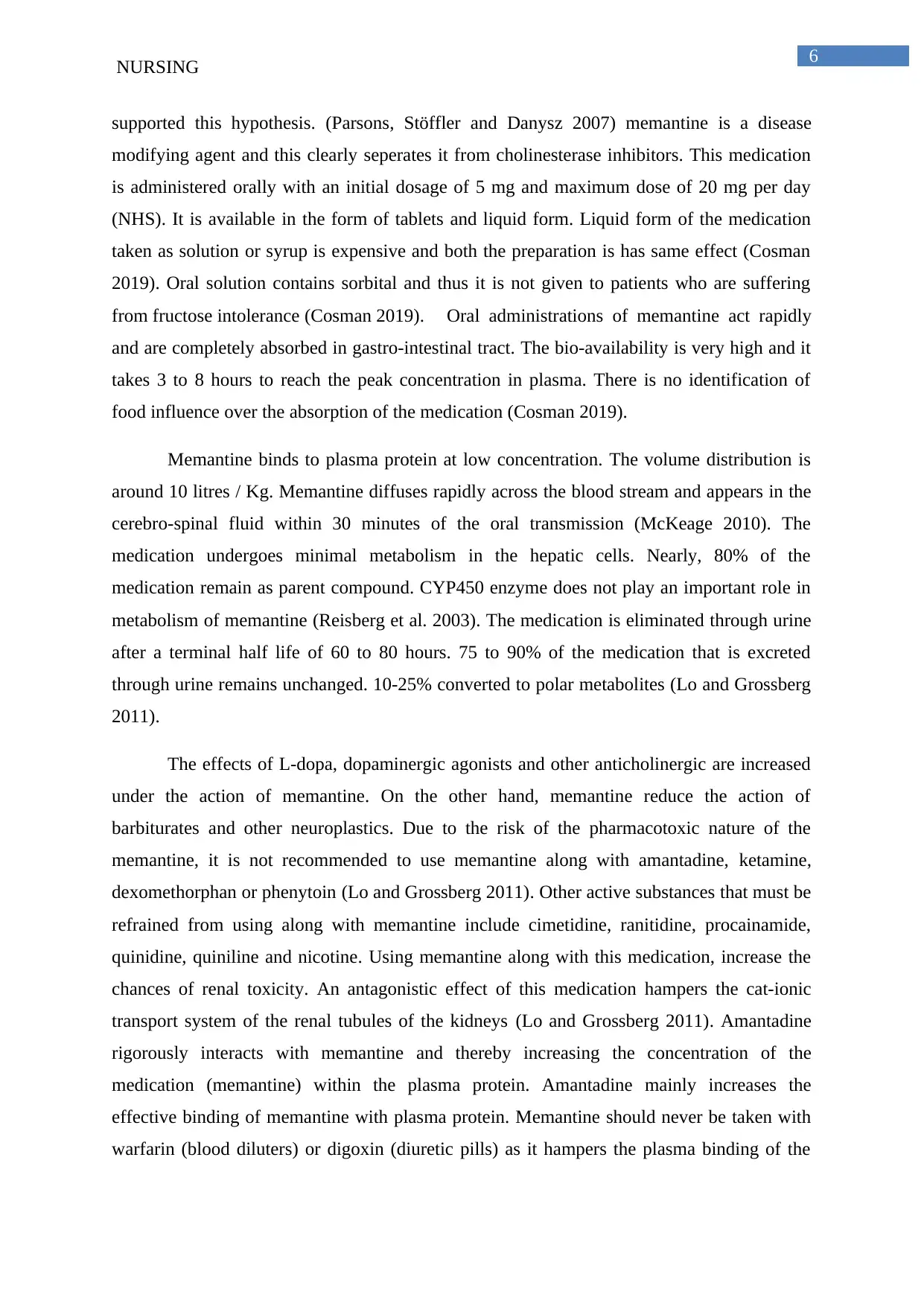
6
NURSING
supported this hypothesis. (Parsons, Stöffler and Danysz 2007) memantine is a disease
modifying agent and this clearly seperates it from cholinesterase inhibitors. This medication
is administered orally with an initial dosage of 5 mg and maximum dose of 20 mg per day
(NHS). It is available in the form of tablets and liquid form. Liquid form of the medication
taken as solution or syrup is expensive and both the preparation is has same effect (Cosman
2019). Oral solution contains sorbital and thus it is not given to patients who are suffering
from fructose intolerance (Cosman 2019). Oral administrations of memantine act rapidly
and are completely absorbed in gastro-intestinal tract. The bio-availability is very high and it
takes 3 to 8 hours to reach the peak concentration in plasma. There is no identification of
food influence over the absorption of the medication (Cosman 2019).
Memantine binds to plasma protein at low concentration. The volume distribution is
around 10 litres / Kg. Memantine diffuses rapidly across the blood stream and appears in the
cerebro-spinal fluid within 30 minutes of the oral transmission (McKeage 2010). The
medication undergoes minimal metabolism in the hepatic cells. Nearly, 80% of the
medication remain as parent compound. CYP450 enzyme does not play an important role in
metabolism of memantine (Reisberg et al. 2003). The medication is eliminated through urine
after a terminal half life of 60 to 80 hours. 75 to 90% of the medication that is excreted
through urine remains unchanged. 10-25% converted to polar metabolites (Lo and Grossberg
2011).
The effects of L-dopa, dopaminergic agonists and other anticholinergic are increased
under the action of memantine. On the other hand, memantine reduce the action of
barbiturates and other neuroplastics. Due to the risk of the pharmacotoxic nature of the
memantine, it is not recommended to use memantine along with amantadine, ketamine,
dexomethorphan or phenytoin (Lo and Grossberg 2011). Other active substances that must be
refrained from using along with memantine include cimetidine, ranitidine, procainamide,
quinidine, quiniline and nicotine. Using memantine along with this medication, increase the
chances of renal toxicity. An antagonistic effect of this medication hampers the cat-ionic
transport system of the renal tubules of the kidneys (Lo and Grossberg 2011). Amantadine
rigorously interacts with memantine and thereby increasing the concentration of the
medication (memantine) within the plasma protein. Amantadine mainly increases the
effective binding of memantine with plasma protein. Memantine should never be taken with
warfarin (blood diluters) or digoxin (diuretic pills) as it hampers the plasma binding of the
NURSING
supported this hypothesis. (Parsons, Stöffler and Danysz 2007) memantine is a disease
modifying agent and this clearly seperates it from cholinesterase inhibitors. This medication
is administered orally with an initial dosage of 5 mg and maximum dose of 20 mg per day
(NHS). It is available in the form of tablets and liquid form. Liquid form of the medication
taken as solution or syrup is expensive and both the preparation is has same effect (Cosman
2019). Oral solution contains sorbital and thus it is not given to patients who are suffering
from fructose intolerance (Cosman 2019). Oral administrations of memantine act rapidly
and are completely absorbed in gastro-intestinal tract. The bio-availability is very high and it
takes 3 to 8 hours to reach the peak concentration in plasma. There is no identification of
food influence over the absorption of the medication (Cosman 2019).
Memantine binds to plasma protein at low concentration. The volume distribution is
around 10 litres / Kg. Memantine diffuses rapidly across the blood stream and appears in the
cerebro-spinal fluid within 30 minutes of the oral transmission (McKeage 2010). The
medication undergoes minimal metabolism in the hepatic cells. Nearly, 80% of the
medication remain as parent compound. CYP450 enzyme does not play an important role in
metabolism of memantine (Reisberg et al. 2003). The medication is eliminated through urine
after a terminal half life of 60 to 80 hours. 75 to 90% of the medication that is excreted
through urine remains unchanged. 10-25% converted to polar metabolites (Lo and Grossberg
2011).
The effects of L-dopa, dopaminergic agonists and other anticholinergic are increased
under the action of memantine. On the other hand, memantine reduce the action of
barbiturates and other neuroplastics. Due to the risk of the pharmacotoxic nature of the
memantine, it is not recommended to use memantine along with amantadine, ketamine,
dexomethorphan or phenytoin (Lo and Grossberg 2011). Other active substances that must be
refrained from using along with memantine include cimetidine, ranitidine, procainamide,
quinidine, quiniline and nicotine. Using memantine along with this medication, increase the
chances of renal toxicity. An antagonistic effect of this medication hampers the cat-ionic
transport system of the renal tubules of the kidneys (Lo and Grossberg 2011). Amantadine
rigorously interacts with memantine and thereby increasing the concentration of the
medication (memantine) within the plasma protein. Amantadine mainly increases the
effective binding of memantine with plasma protein. Memantine should never be taken with
warfarin (blood diluters) or digoxin (diuretic pills) as it hampers the plasma binding of the
Paraphrase This Document
Need a fresh take? Get an instant paraphrase of this document with our AI Paraphraser
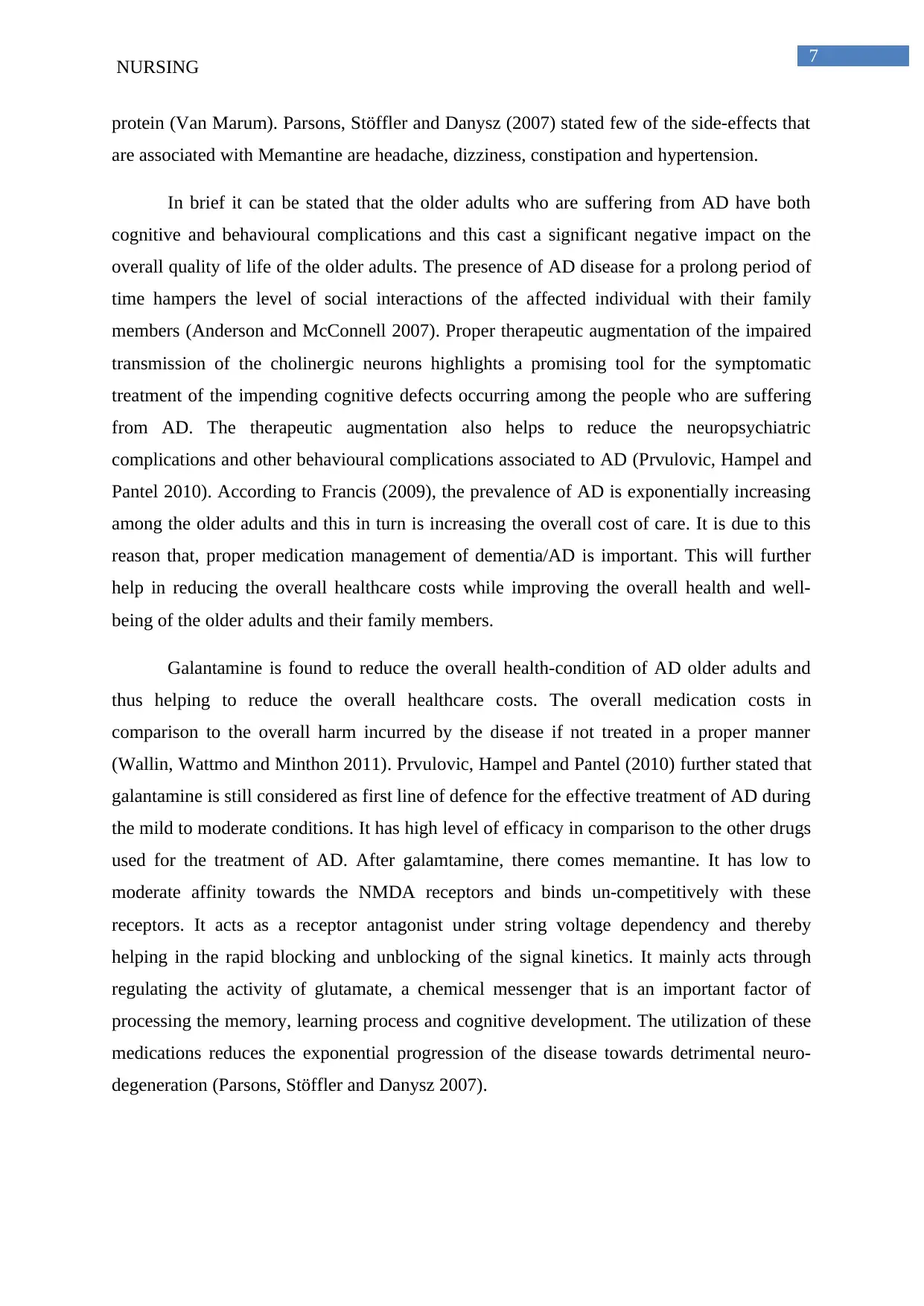
7
NURSING
protein (Van Marum). Parsons, Stöffler and Danysz (2007) stated few of the side-effects that
are associated with Memantine are headache, dizziness, constipation and hypertension.
In brief it can be stated that the older adults who are suffering from AD have both
cognitive and behavioural complications and this cast a significant negative impact on the
overall quality of life of the older adults. The presence of AD disease for a prolong period of
time hampers the level of social interactions of the affected individual with their family
members (Anderson and McConnell 2007). Proper therapeutic augmentation of the impaired
transmission of the cholinergic neurons highlights a promising tool for the symptomatic
treatment of the impending cognitive defects occurring among the people who are suffering
from AD. The therapeutic augmentation also helps to reduce the neuropsychiatric
complications and other behavioural complications associated to AD (Prvulovic, Hampel and
Pantel 2010). According to Francis (2009), the prevalence of AD is exponentially increasing
among the older adults and this in turn is increasing the overall cost of care. It is due to this
reason that, proper medication management of dementia/AD is important. This will further
help in reducing the overall healthcare costs while improving the overall health and well-
being of the older adults and their family members.
Galantamine is found to reduce the overall health-condition of AD older adults and
thus helping to reduce the overall healthcare costs. The overall medication costs in
comparison to the overall harm incurred by the disease if not treated in a proper manner
(Wallin, Wattmo and Minthon 2011). Prvulovic, Hampel and Pantel (2010) further stated that
galantamine is still considered as first line of defence for the effective treatment of AD during
the mild to moderate conditions. It has high level of efficacy in comparison to the other drugs
used for the treatment of AD. After galamtamine, there comes memantine. It has low to
moderate affinity towards the NMDA receptors and binds un-competitively with these
receptors. It acts as a receptor antagonist under string voltage dependency and thereby
helping in the rapid blocking and unblocking of the signal kinetics. It mainly acts through
regulating the activity of glutamate, a chemical messenger that is an important factor of
processing the memory, learning process and cognitive development. The utilization of these
medications reduces the exponential progression of the disease towards detrimental neuro-
degeneration (Parsons, Stöffler and Danysz 2007).
NURSING
protein (Van Marum). Parsons, Stöffler and Danysz (2007) stated few of the side-effects that
are associated with Memantine are headache, dizziness, constipation and hypertension.
In brief it can be stated that the older adults who are suffering from AD have both
cognitive and behavioural complications and this cast a significant negative impact on the
overall quality of life of the older adults. The presence of AD disease for a prolong period of
time hampers the level of social interactions of the affected individual with their family
members (Anderson and McConnell 2007). Proper therapeutic augmentation of the impaired
transmission of the cholinergic neurons highlights a promising tool for the symptomatic
treatment of the impending cognitive defects occurring among the people who are suffering
from AD. The therapeutic augmentation also helps to reduce the neuropsychiatric
complications and other behavioural complications associated to AD (Prvulovic, Hampel and
Pantel 2010). According to Francis (2009), the prevalence of AD is exponentially increasing
among the older adults and this in turn is increasing the overall cost of care. It is due to this
reason that, proper medication management of dementia/AD is important. This will further
help in reducing the overall healthcare costs while improving the overall health and well-
being of the older adults and their family members.
Galantamine is found to reduce the overall health-condition of AD older adults and
thus helping to reduce the overall healthcare costs. The overall medication costs in
comparison to the overall harm incurred by the disease if not treated in a proper manner
(Wallin, Wattmo and Minthon 2011). Prvulovic, Hampel and Pantel (2010) further stated that
galantamine is still considered as first line of defence for the effective treatment of AD during
the mild to moderate conditions. It has high level of efficacy in comparison to the other drugs
used for the treatment of AD. After galamtamine, there comes memantine. It has low to
moderate affinity towards the NMDA receptors and binds un-competitively with these
receptors. It acts as a receptor antagonist under string voltage dependency and thereby
helping in the rapid blocking and unblocking of the signal kinetics. It mainly acts through
regulating the activity of glutamate, a chemical messenger that is an important factor of
processing the memory, learning process and cognitive development. The utilization of these
medications reduces the exponential progression of the disease towards detrimental neuro-
degeneration (Parsons, Stöffler and Danysz 2007).
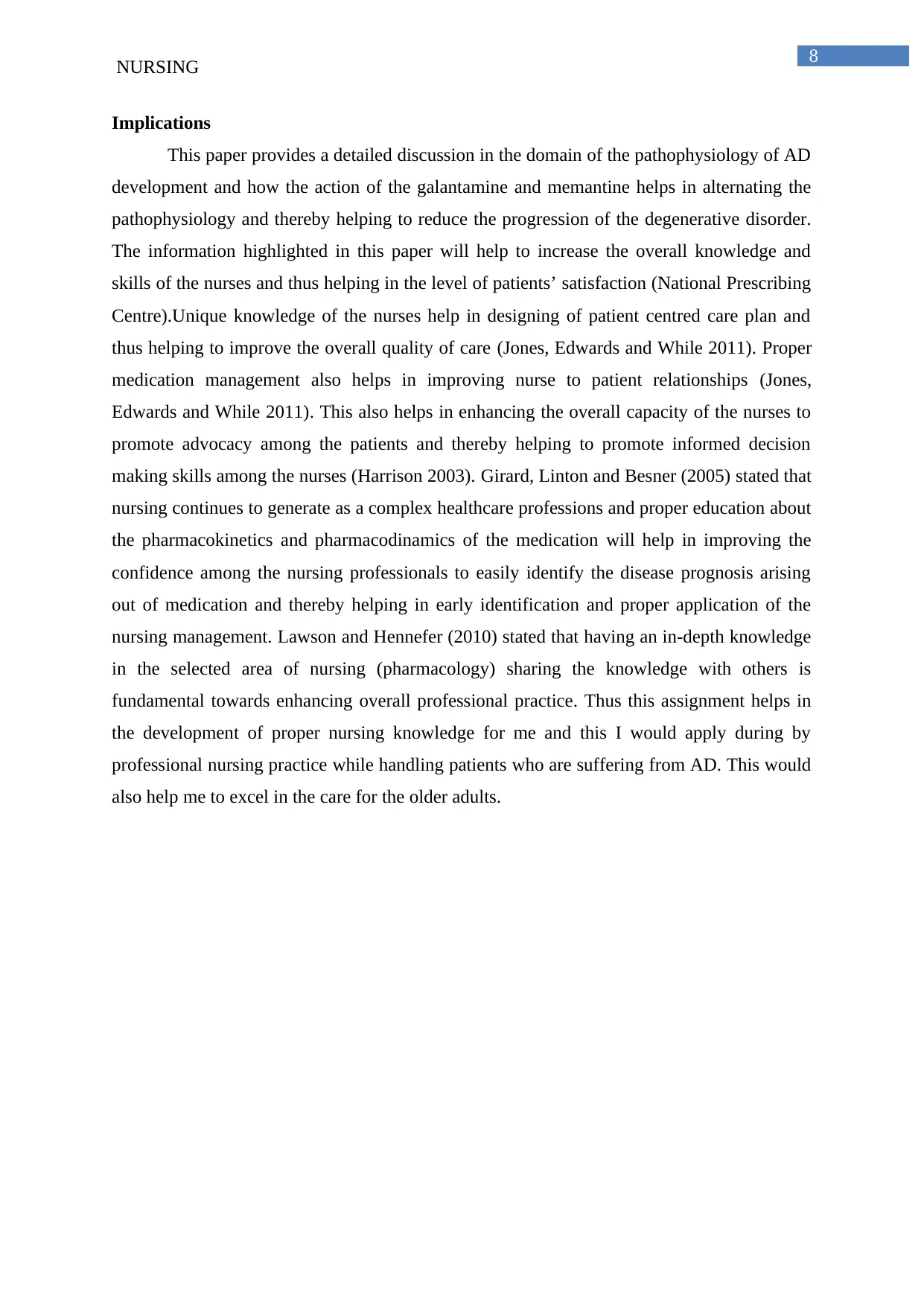
8
NURSING
Implications
This paper provides a detailed discussion in the domain of the pathophysiology of AD
development and how the action of the galantamine and memantine helps in alternating the
pathophysiology and thereby helping to reduce the progression of the degenerative disorder.
The information highlighted in this paper will help to increase the overall knowledge and
skills of the nurses and thus helping in the level of patients’ satisfaction (National Prescribing
Centre).Unique knowledge of the nurses help in designing of patient centred care plan and
thus helping to improve the overall quality of care (Jones, Edwards and While 2011). Proper
medication management also helps in improving nurse to patient relationships (Jones,
Edwards and While 2011). This also helps in enhancing the overall capacity of the nurses to
promote advocacy among the patients and thereby helping to promote informed decision
making skills among the nurses (Harrison 2003). Girard, Linton and Besner (2005) stated that
nursing continues to generate as a complex healthcare professions and proper education about
the pharmacokinetics and pharmacodinamics of the medication will help in improving the
confidence among the nursing professionals to easily identify the disease prognosis arising
out of medication and thereby helping in early identification and proper application of the
nursing management. Lawson and Hennefer (2010) stated that having an in-depth knowledge
in the selected area of nursing (pharmacology) sharing the knowledge with others is
fundamental towards enhancing overall professional practice. Thus this assignment helps in
the development of proper nursing knowledge for me and this I would apply during by
professional nursing practice while handling patients who are suffering from AD. This would
also help me to excel in the care for the older adults.
NURSING
Implications
This paper provides a detailed discussion in the domain of the pathophysiology of AD
development and how the action of the galantamine and memantine helps in alternating the
pathophysiology and thereby helping to reduce the progression of the degenerative disorder.
The information highlighted in this paper will help to increase the overall knowledge and
skills of the nurses and thus helping in the level of patients’ satisfaction (National Prescribing
Centre).Unique knowledge of the nurses help in designing of patient centred care plan and
thus helping to improve the overall quality of care (Jones, Edwards and While 2011). Proper
medication management also helps in improving nurse to patient relationships (Jones,
Edwards and While 2011). This also helps in enhancing the overall capacity of the nurses to
promote advocacy among the patients and thereby helping to promote informed decision
making skills among the nurses (Harrison 2003). Girard, Linton and Besner (2005) stated that
nursing continues to generate as a complex healthcare professions and proper education about
the pharmacokinetics and pharmacodinamics of the medication will help in improving the
confidence among the nursing professionals to easily identify the disease prognosis arising
out of medication and thereby helping in early identification and proper application of the
nursing management. Lawson and Hennefer (2010) stated that having an in-depth knowledge
in the selected area of nursing (pharmacology) sharing the knowledge with others is
fundamental towards enhancing overall professional practice. Thus this assignment helps in
the development of proper nursing knowledge for me and this I would apply during by
professional nursing practice while handling patients who are suffering from AD. This would
also help me to excel in the care for the older adults.
⊘ This is a preview!⊘
Do you want full access?
Subscribe today to unlock all pages.

Trusted by 1+ million students worldwide
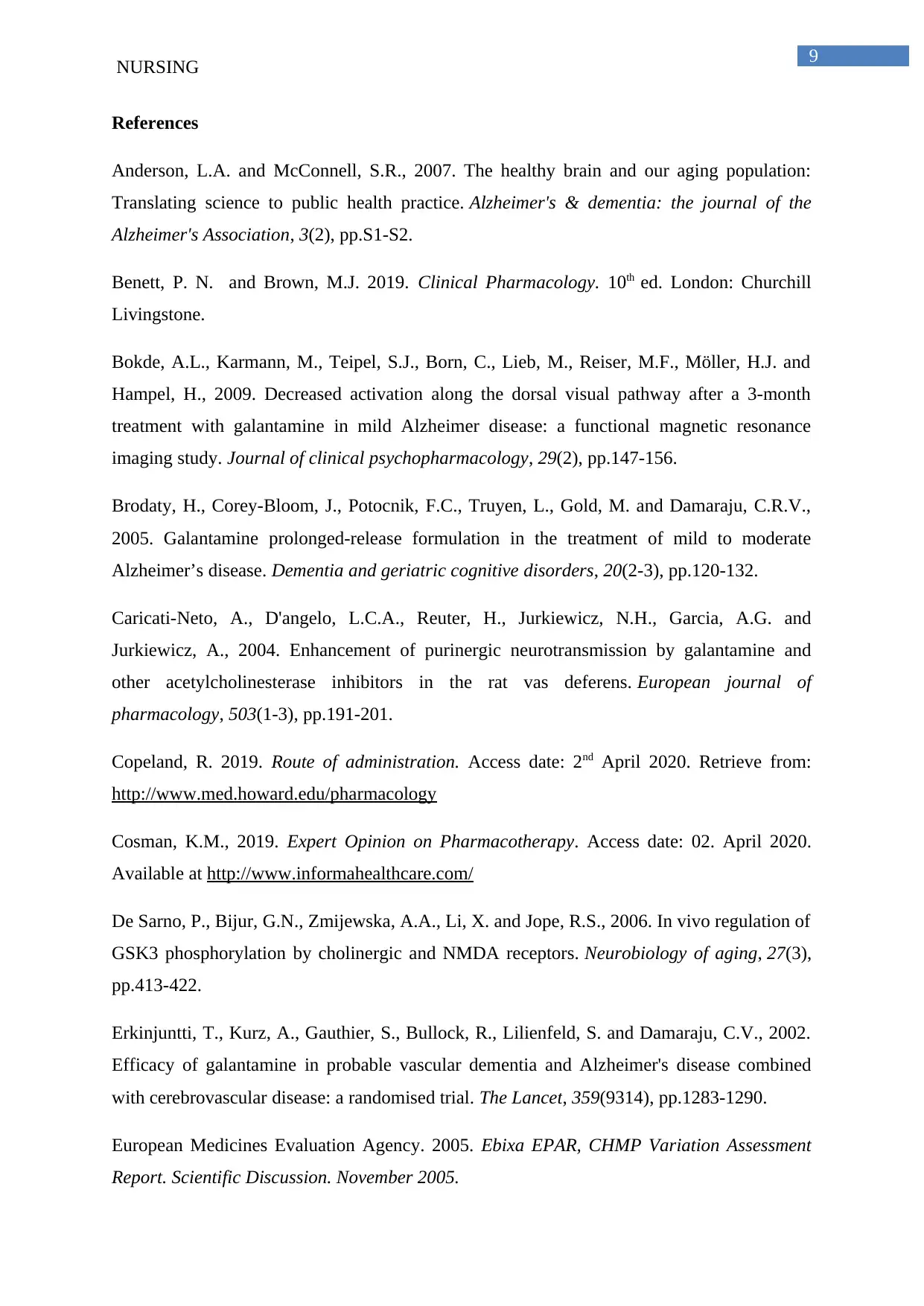
9
NURSING
References
Anderson, L.A. and McConnell, S.R., 2007. The healthy brain and our aging population:
Translating science to public health practice. Alzheimer's & dementia: the journal of the
Alzheimer's Association, 3(2), pp.S1-S2.
Benett, P. N. and Brown, M.J. 2019. Clinical Pharmacology. 10th ed. London: Churchill
Livingstone.
Bokde, A.L., Karmann, M., Teipel, S.J., Born, C., Lieb, M., Reiser, M.F., Möller, H.J. and
Hampel, H., 2009. Decreased activation along the dorsal visual pathway after a 3-month
treatment with galantamine in mild Alzheimer disease: a functional magnetic resonance
imaging study. Journal of clinical psychopharmacology, 29(2), pp.147-156.
Brodaty, H., Corey-Bloom, J., Potocnik, F.C., Truyen, L., Gold, M. and Damaraju, C.R.V.,
2005. Galantamine prolonged-release formulation in the treatment of mild to moderate
Alzheimer’s disease. Dementia and geriatric cognitive disorders, 20(2-3), pp.120-132.
Caricati-Neto, A., D'angelo, L.C.A., Reuter, H., Jurkiewicz, N.H., Garcia, A.G. and
Jurkiewicz, A., 2004. Enhancement of purinergic neurotransmission by galantamine and
other acetylcholinesterase inhibitors in the rat vas deferens. European journal of
pharmacology, 503(1-3), pp.191-201.
Copeland, R. 2019. Route of administration. Access date: 2nd April 2020. Retrieve from:
http://www.med.howard.edu/pharmacology
Cosman, K.M., 2019. Expert Opinion on Pharmacotherapy. Access date: 02. April 2020.
Available at http://www.informahealthcare.com/
De Sarno, P., Bijur, G.N., Zmijewska, A.A., Li, X. and Jope, R.S., 2006. In vivo regulation of
GSK3 phosphorylation by cholinergic and NMDA receptors. Neurobiology of aging, 27(3),
pp.413-422.
Erkinjuntti, T., Kurz, A., Gauthier, S., Bullock, R., Lilienfeld, S. and Damaraju, C.V., 2002.
Efficacy of galantamine in probable vascular dementia and Alzheimer's disease combined
with cerebrovascular disease: a randomised trial. The Lancet, 359(9314), pp.1283-1290.
European Medicines Evaluation Agency. 2005. Ebixa EPAR, CHMP Variation Assessment
Report. Scientific Discussion. November 2005.
NURSING
References
Anderson, L.A. and McConnell, S.R., 2007. The healthy brain and our aging population:
Translating science to public health practice. Alzheimer's & dementia: the journal of the
Alzheimer's Association, 3(2), pp.S1-S2.
Benett, P. N. and Brown, M.J. 2019. Clinical Pharmacology. 10th ed. London: Churchill
Livingstone.
Bokde, A.L., Karmann, M., Teipel, S.J., Born, C., Lieb, M., Reiser, M.F., Möller, H.J. and
Hampel, H., 2009. Decreased activation along the dorsal visual pathway after a 3-month
treatment with galantamine in mild Alzheimer disease: a functional magnetic resonance
imaging study. Journal of clinical psychopharmacology, 29(2), pp.147-156.
Brodaty, H., Corey-Bloom, J., Potocnik, F.C., Truyen, L., Gold, M. and Damaraju, C.R.V.,
2005. Galantamine prolonged-release formulation in the treatment of mild to moderate
Alzheimer’s disease. Dementia and geriatric cognitive disorders, 20(2-3), pp.120-132.
Caricati-Neto, A., D'angelo, L.C.A., Reuter, H., Jurkiewicz, N.H., Garcia, A.G. and
Jurkiewicz, A., 2004. Enhancement of purinergic neurotransmission by galantamine and
other acetylcholinesterase inhibitors in the rat vas deferens. European journal of
pharmacology, 503(1-3), pp.191-201.
Copeland, R. 2019. Route of administration. Access date: 2nd April 2020. Retrieve from:
http://www.med.howard.edu/pharmacology
Cosman, K.M., 2019. Expert Opinion on Pharmacotherapy. Access date: 02. April 2020.
Available at http://www.informahealthcare.com/
De Sarno, P., Bijur, G.N., Zmijewska, A.A., Li, X. and Jope, R.S., 2006. In vivo regulation of
GSK3 phosphorylation by cholinergic and NMDA receptors. Neurobiology of aging, 27(3),
pp.413-422.
Erkinjuntti, T., Kurz, A., Gauthier, S., Bullock, R., Lilienfeld, S. and Damaraju, C.V., 2002.
Efficacy of galantamine in probable vascular dementia and Alzheimer's disease combined
with cerebrovascular disease: a randomised trial. The Lancet, 359(9314), pp.1283-1290.
European Medicines Evaluation Agency. 2005. Ebixa EPAR, CHMP Variation Assessment
Report. Scientific Discussion. November 2005.
Paraphrase This Document
Need a fresh take? Get an instant paraphrase of this document with our AI Paraphraser
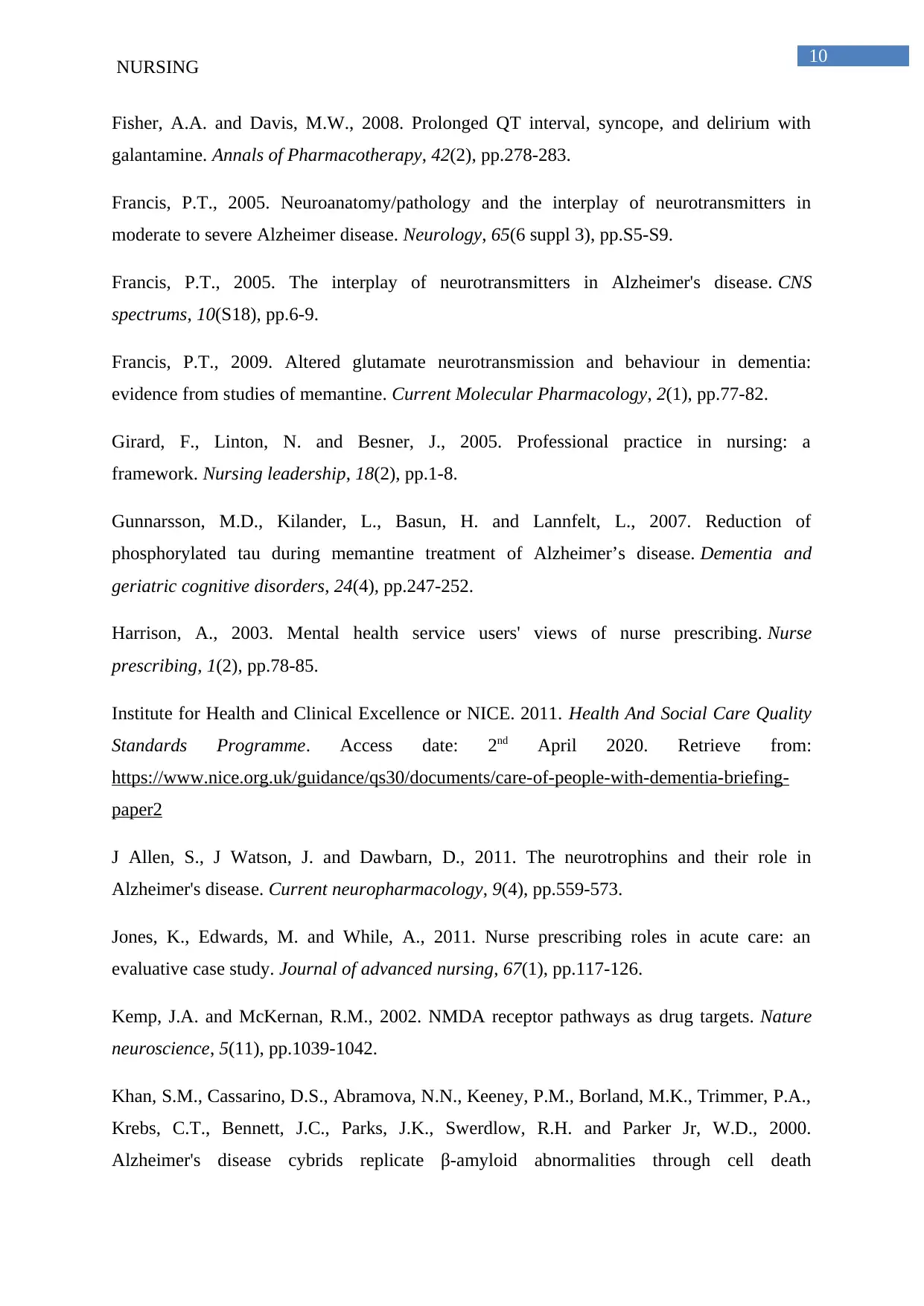
10
NURSING
Fisher, A.A. and Davis, M.W., 2008. Prolonged QT interval, syncope, and delirium with
galantamine. Annals of Pharmacotherapy, 42(2), pp.278-283.
Francis, P.T., 2005. Neuroanatomy/pathology and the interplay of neurotransmitters in
moderate to severe Alzheimer disease. Neurology, 65(6 suppl 3), pp.S5-S9.
Francis, P.T., 2005. The interplay of neurotransmitters in Alzheimer's disease. CNS
spectrums, 10(S18), pp.6-9.
Francis, P.T., 2009. Altered glutamate neurotransmission and behaviour in dementia:
evidence from studies of memantine. Current Molecular Pharmacology, 2(1), pp.77-82.
Girard, F., Linton, N. and Besner, J., 2005. Professional practice in nursing: a
framework. Nursing leadership, 18(2), pp.1-8.
Gunnarsson, M.D., Kilander, L., Basun, H. and Lannfelt, L., 2007. Reduction of
phosphorylated tau during memantine treatment of Alzheimer’s disease. Dementia and
geriatric cognitive disorders, 24(4), pp.247-252.
Harrison, A., 2003. Mental health service users' views of nurse prescribing. Nurse
prescribing, 1(2), pp.78-85.
Institute for Health and Clinical Excellence or NICE. 2011. Health And Social Care Quality
Standards Programme. Access date: 2nd April 2020. Retrieve from:
https://www.nice.org.uk/guidance/qs30/documents/care-of-people-with-dementia-briefing-
paper2
J Allen, S., J Watson, J. and Dawbarn, D., 2011. The neurotrophins and their role in
Alzheimer's disease. Current neuropharmacology, 9(4), pp.559-573.
Jones, K., Edwards, M. and While, A., 2011. Nurse prescribing roles in acute care: an
evaluative case study. Journal of advanced nursing, 67(1), pp.117-126.
Kemp, J.A. and McKernan, R.M., 2002. NMDA receptor pathways as drug targets. Nature
neuroscience, 5(11), pp.1039-1042.
Khan, S.M., Cassarino, D.S., Abramova, N.N., Keeney, P.M., Borland, M.K., Trimmer, P.A.,
Krebs, C.T., Bennett, J.C., Parks, J.K., Swerdlow, R.H. and Parker Jr, W.D., 2000.
Alzheimer's disease cybrids replicate β‐amyloid abnormalities through cell death
NURSING
Fisher, A.A. and Davis, M.W., 2008. Prolonged QT interval, syncope, and delirium with
galantamine. Annals of Pharmacotherapy, 42(2), pp.278-283.
Francis, P.T., 2005. Neuroanatomy/pathology and the interplay of neurotransmitters in
moderate to severe Alzheimer disease. Neurology, 65(6 suppl 3), pp.S5-S9.
Francis, P.T., 2005. The interplay of neurotransmitters in Alzheimer's disease. CNS
spectrums, 10(S18), pp.6-9.
Francis, P.T., 2009. Altered glutamate neurotransmission and behaviour in dementia:
evidence from studies of memantine. Current Molecular Pharmacology, 2(1), pp.77-82.
Girard, F., Linton, N. and Besner, J., 2005. Professional practice in nursing: a
framework. Nursing leadership, 18(2), pp.1-8.
Gunnarsson, M.D., Kilander, L., Basun, H. and Lannfelt, L., 2007. Reduction of
phosphorylated tau during memantine treatment of Alzheimer’s disease. Dementia and
geriatric cognitive disorders, 24(4), pp.247-252.
Harrison, A., 2003. Mental health service users' views of nurse prescribing. Nurse
prescribing, 1(2), pp.78-85.
Institute for Health and Clinical Excellence or NICE. 2011. Health And Social Care Quality
Standards Programme. Access date: 2nd April 2020. Retrieve from:
https://www.nice.org.uk/guidance/qs30/documents/care-of-people-with-dementia-briefing-
paper2
J Allen, S., J Watson, J. and Dawbarn, D., 2011. The neurotrophins and their role in
Alzheimer's disease. Current neuropharmacology, 9(4), pp.559-573.
Jones, K., Edwards, M. and While, A., 2011. Nurse prescribing roles in acute care: an
evaluative case study. Journal of advanced nursing, 67(1), pp.117-126.
Kemp, J.A. and McKernan, R.M., 2002. NMDA receptor pathways as drug targets. Nature
neuroscience, 5(11), pp.1039-1042.
Khan, S.M., Cassarino, D.S., Abramova, N.N., Keeney, P.M., Borland, M.K., Trimmer, P.A.,
Krebs, C.T., Bennett, J.C., Parks, J.K., Swerdlow, R.H. and Parker Jr, W.D., 2000.
Alzheimer's disease cybrids replicate β‐amyloid abnormalities through cell death
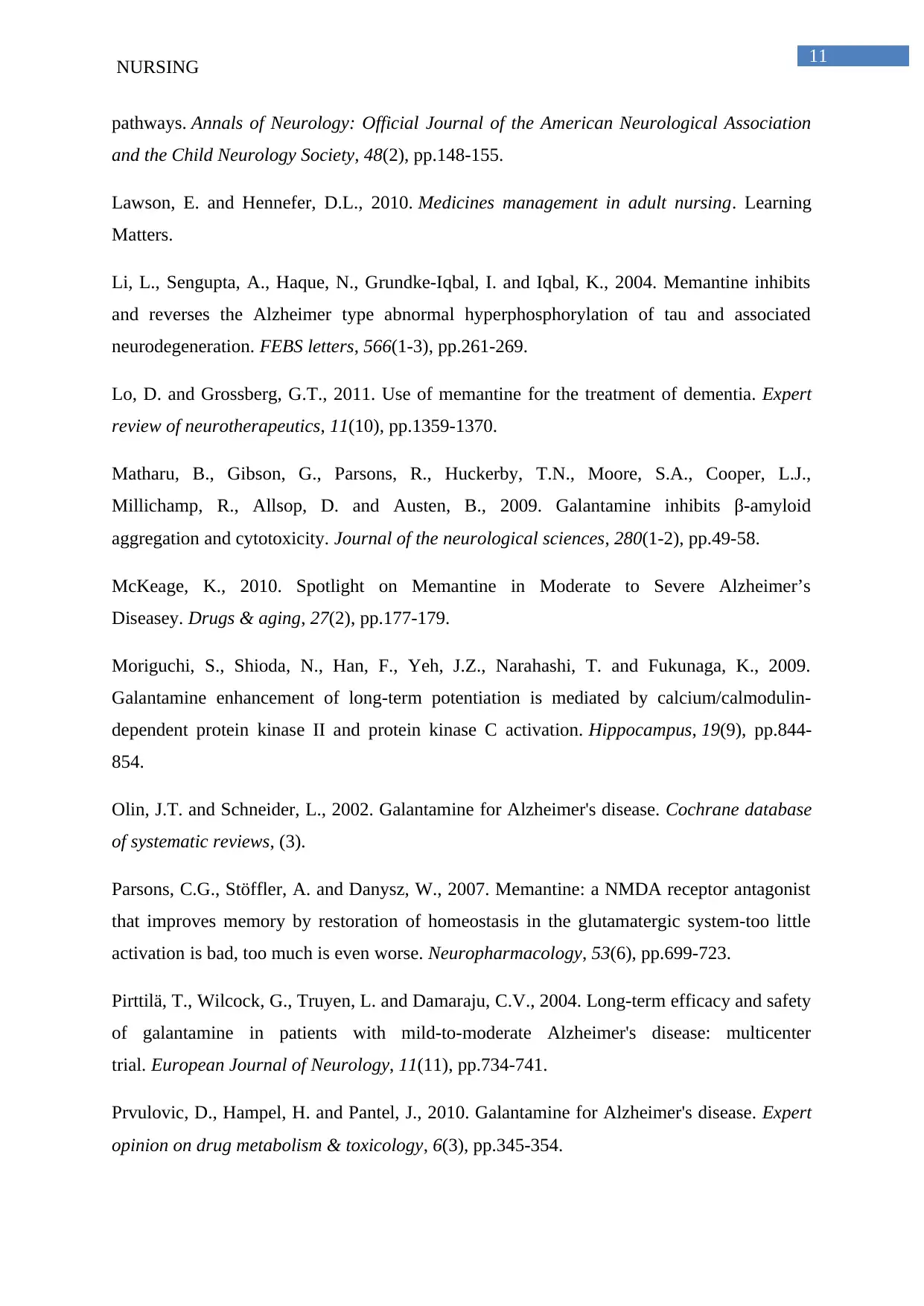
11
NURSING
pathways. Annals of Neurology: Official Journal of the American Neurological Association
and the Child Neurology Society, 48(2), pp.148-155.
Lawson, E. and Hennefer, D.L., 2010. Medicines management in adult nursing. Learning
Matters.
Li, L., Sengupta, A., Haque, N., Grundke-Iqbal, I. and Iqbal, K., 2004. Memantine inhibits
and reverses the Alzheimer type abnormal hyperphosphorylation of tau and associated
neurodegeneration. FEBS letters, 566(1-3), pp.261-269.
Lo, D. and Grossberg, G.T., 2011. Use of memantine for the treatment of dementia. Expert
review of neurotherapeutics, 11(10), pp.1359-1370.
Matharu, B., Gibson, G., Parsons, R., Huckerby, T.N., Moore, S.A., Cooper, L.J.,
Millichamp, R., Allsop, D. and Austen, B., 2009. Galantamine inhibits β-amyloid
aggregation and cytotoxicity. Journal of the neurological sciences, 280(1-2), pp.49-58.
McKeage, K., 2010. Spotlight on Memantine in Moderate to Severe Alzheimer’s
Diseasey. Drugs & aging, 27(2), pp.177-179.
Moriguchi, S., Shioda, N., Han, F., Yeh, J.Z., Narahashi, T. and Fukunaga, K., 2009.
Galantamine enhancement of long‐term potentiation is mediated by calcium/calmodulin‐
dependent protein kinase II and protein kinase C activation. Hippocampus, 19(9), pp.844-
854.
Olin, J.T. and Schneider, L., 2002. Galantamine for Alzheimer's disease. Cochrane database
of systematic reviews, (3).
Parsons, C.G., Stöffler, A. and Danysz, W., 2007. Memantine: a NMDA receptor antagonist
that improves memory by restoration of homeostasis in the glutamatergic system-too little
activation is bad, too much is even worse. Neuropharmacology, 53(6), pp.699-723.
Pirttilä, T., Wilcock, G., Truyen, L. and Damaraju, C.V., 2004. Long‐term efficacy and safety
of galantamine in patients with mild‐to‐moderate Alzheimer's disease: multicenter
trial. European Journal of Neurology, 11(11), pp.734-741.
Prvulovic, D., Hampel, H. and Pantel, J., 2010. Galantamine for Alzheimer's disease. Expert
opinion on drug metabolism & toxicology, 6(3), pp.345-354.
NURSING
pathways. Annals of Neurology: Official Journal of the American Neurological Association
and the Child Neurology Society, 48(2), pp.148-155.
Lawson, E. and Hennefer, D.L., 2010. Medicines management in adult nursing. Learning
Matters.
Li, L., Sengupta, A., Haque, N., Grundke-Iqbal, I. and Iqbal, K., 2004. Memantine inhibits
and reverses the Alzheimer type abnormal hyperphosphorylation of tau and associated
neurodegeneration. FEBS letters, 566(1-3), pp.261-269.
Lo, D. and Grossberg, G.T., 2011. Use of memantine for the treatment of dementia. Expert
review of neurotherapeutics, 11(10), pp.1359-1370.
Matharu, B., Gibson, G., Parsons, R., Huckerby, T.N., Moore, S.A., Cooper, L.J.,
Millichamp, R., Allsop, D. and Austen, B., 2009. Galantamine inhibits β-amyloid
aggregation and cytotoxicity. Journal of the neurological sciences, 280(1-2), pp.49-58.
McKeage, K., 2010. Spotlight on Memantine in Moderate to Severe Alzheimer’s
Diseasey. Drugs & aging, 27(2), pp.177-179.
Moriguchi, S., Shioda, N., Han, F., Yeh, J.Z., Narahashi, T. and Fukunaga, K., 2009.
Galantamine enhancement of long‐term potentiation is mediated by calcium/calmodulin‐
dependent protein kinase II and protein kinase C activation. Hippocampus, 19(9), pp.844-
854.
Olin, J.T. and Schneider, L., 2002. Galantamine for Alzheimer's disease. Cochrane database
of systematic reviews, (3).
Parsons, C.G., Stöffler, A. and Danysz, W., 2007. Memantine: a NMDA receptor antagonist
that improves memory by restoration of homeostasis in the glutamatergic system-too little
activation is bad, too much is even worse. Neuropharmacology, 53(6), pp.699-723.
Pirttilä, T., Wilcock, G., Truyen, L. and Damaraju, C.V., 2004. Long‐term efficacy and safety
of galantamine in patients with mild‐to‐moderate Alzheimer's disease: multicenter
trial. European Journal of Neurology, 11(11), pp.734-741.
Prvulovic, D., Hampel, H. and Pantel, J., 2010. Galantamine for Alzheimer's disease. Expert
opinion on drug metabolism & toxicology, 6(3), pp.345-354.
⊘ This is a preview!⊘
Do you want full access?
Subscribe today to unlock all pages.

Trusted by 1+ million students worldwide
1 out of 13
Your All-in-One AI-Powered Toolkit for Academic Success.
+13062052269
info@desklib.com
Available 24*7 on WhatsApp / Email
![[object Object]](/_next/static/media/star-bottom.7253800d.svg)
Unlock your academic potential
Copyright © 2020–2025 A2Z Services. All Rights Reserved. Developed and managed by ZUCOL.
